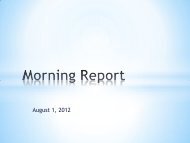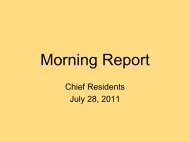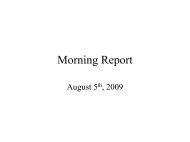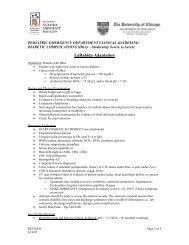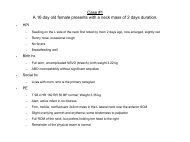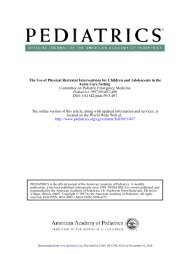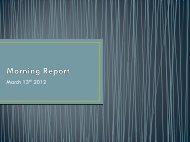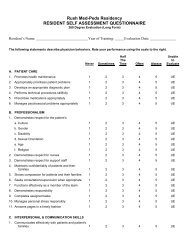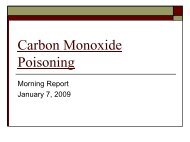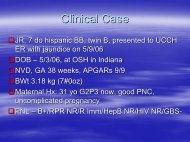01 Long QT Syndrome
01 Long QT Syndrome
01 Long QT Syndrome
Create successful ePaper yourself
Turn your PDF publications into a flip-book with our unique Google optimized e-Paper software.
17 year-old M who<br />
collapsed in<br />
overtime
PMH<br />
• Passed out once<br />
• Migraines<br />
PSH<br />
Noncontributory<br />
Allergies<br />
NKDA<br />
Medications<br />
Ibuprofen prn<br />
Sumitriptan prn<br />
Fam Hx<br />
• Paternal uncle died at age 30 -<br />
unexplained MVA<br />
• Cousin died from SIDS at 3 mo<br />
Soc Hx<br />
• LAHW both parents.<br />
• Plays basketball year-round.<br />
• Does well in school.<br />
• Tried marijuana. No other<br />
drugs. No alcohol.<br />
• 2 sexual partners, uses<br />
condoms.
Gen:<br />
HEENT:<br />
CV:<br />
Resp:<br />
Abd:<br />
MSk:<br />
Neuro:<br />
Skin:<br />
VS:<br />
37.5 112/64 88 14 99% RA<br />
Wt: 188 lbs Ht: 6’4” BMI: 22.9
• 15% before adulthood<br />
• Mostly benign causes<br />
• 75% have vasovagal syncope<br />
Why do we care?<br />
“The only difference between syncope and sudden death is<br />
that in syncope you wake up.”<br />
-- G L Engels
Cardiac syncope<br />
• Electrical disturbances<br />
• <strong>Long</strong> or short <strong>QT</strong> <strong>Syndrome</strong><br />
• WPW<br />
• Structural heart disease<br />
• Hypertrophic CM<br />
• AS<br />
• DCM<br />
• pHTN<br />
• Myocarditis<br />
• Myocardial dysfxn<br />
Neurocardiac syncope<br />
• Vasovagal<br />
• Tilt table test<br />
Noncardiac syncope<br />
• Seizures<br />
• Migraines<br />
• Orthostatic hypotension<br />
• GER<br />
• Metabolic disease<br />
• Situational<br />
• Breath holding spells<br />
• Toxic exposure<br />
• Conversion disorder<br />
• Hyperventilation<br />
• Choking game<br />
• Pregnancy<br />
• Anemia<br />
• CNS lesions
137 102 9<br />
3.9 27 0.6<br />
14.2<br />
6.1 236<br />
42.6<br />
63N 14L<br />
Initial Labs<br />
103 Ca 8.8 Mg 1.9 Phos 3
The<br />
Dreaded<br />
…
• Rate<br />
• Rhythm<br />
• Axis<br />
• Hypertrophy<br />
• Infarction<br />
• Intervals
• Rate<br />
• 300-150-100-75-60-50<br />
• 6-second strip
• Rhythm<br />
• Sinus?
• Axis<br />
• Normal?<br />
• LAD?<br />
• RAD?
• Hypertrophy<br />
• RAE<br />
• LAE<br />
• RVH<br />
• LVH
RAE – too tall LAE – too wide<br />
LVH RVH<br />
II<br />
VI
• Hypertrophy<br />
• RAE<br />
• LAE<br />
• RVH<br />
• LVH
• Infarction<br />
• ST segments<br />
• T waves<br />
• Q waves
• Intervals<br />
• PR<br />
• QRS<br />
• <strong>QT</strong><br />
• RR
<strong>QT</strong>c = <strong>QT</strong><br />
RR
Prolonged <strong>QT</strong>c interval
Types<br />
1) Acquired<br />
2) Congenital<br />
• >50 genetic mutations in 4 cardiac ion channels<br />
• >10 L<strong>QT</strong> gene loci, KVL<strong>QT</strong>1<br />
Epidemiology<br />
• 18 Italian hospitals<br />
(20<strong>01</strong>-2006)<br />
• 7 L<strong>QT</strong>S genes found<br />
• Prevalence 1:2534<br />
(95% CI 1:1583 to 1:4350)<br />
Prevalence of the Congenital <strong>Long</strong>-<strong>QT</strong> <strong>Syndrome</strong>.<br />
Schwartz, P., Stramba-Badiale, M, et al. Circulation<br />
2009; 120: 1761-1767.
Life-threatening arrhythmias<br />
• Torsades de pointes
http://www.nature.com.proxy.uchicago.edu/nrd/journal/v3/n3/fig_tab/nrd1361_F3.html<br />
HERG<br />
• encodes K ch<br />
• important in repolarization<br />
• protects vs early after-<br />
depolarizations<br />
HERG blockade (L<strong>QT</strong>2)<br />
• Meds block IKr current<br />
mediated by K channel
• Antiarrythmics<br />
• Antihistamine<br />
• Benadryl<br />
• Antimicrobials<br />
• Macrolides<br />
• Quinolones<br />
• Bactrim<br />
• Pentamidine<br />
• Azoles<br />
• GI agents<br />
• Cisapride<br />
• Zofran<br />
• Psychiatric drugs**<br />
• Haldol<br />
• TCAs<br />
• Anti-migraine<br />
• Triptans<br />
• Electrolyte disturbances<br />
• Other medical conditions<br />
• Arrhythmias<br />
• Endocrine<br />
• Neurologic<br />
• Nutritional
Romano-Ward <strong>Syndrome</strong><br />
• AD<br />
• KCNQ1, KCNE1, KCNH2,<br />
KCNE2, and SCN5A<br />
• Normal hearing<br />
186 J-LN pts<br />
• Severe variant of L<strong>QT</strong>S<br />
• Major <strong>QT</strong>c prolongation (557)<br />
• KCNE1 mutation<br />
• Early presentation<br />
• SCD rates >25%<br />
• Persistence of sx/SCD on BB<br />
Jervell and Lange-Nielsen <strong>Syndrome</strong><br />
• AR<br />
• KCNQ1 or KCNE1<br />
• Congenital AVB<br />
• Syndactyly<br />
• Sensorineural hearing loss<br />
Schwartz PJ, et al. The Jervell and Lange-Nielsen syndrome: natural history,<br />
molecular basis, and clinical outcome. Circulation. 2006; 113 (6): 783.
Ackerman, M. Consultation with the Specialist: The <strong>Long</strong> <strong>QT</strong> <strong>Syndrome</strong>. Pediatr. Rev. 1998; 19; 232-238.
Medications<br />
• Beta blocker<br />
• IV Magnesium or Isoproterenol<br />
• Pacer/Defibrillator<br />
• Growth<br />
• <strong>Long</strong>evity of device<br />
• Increased physical activity in children<br />
• Sympathetic ganglionectomy<br />
• <strong>QT</strong>c > 600 msec = poor prognostic factor<br />
• NO competitive sports<br />
• Buddies<br />
Schwartz study<br />
• 233 pts over 15 years<br />
• w/o BB: 1-year mortality rate >20%<br />
• w/o BB: 15-year mortality rate >53%
• Discuss the causes of<br />
syncope<br />
• Review of EKG<br />
interpretation<br />
• Review presentation<br />
of L<strong>QT</strong>S<br />
• Review types of L<strong>QT</strong>S<br />
• Review tx of L<strong>QT</strong>S
10-day-old infant with difficulty feeding and cyanosis.<br />
What is her diagnosis?
References<br />
• Willis, J. Syncope. Pediatr. Rev. 2000; 21; 2<strong>01</strong>-204.<br />
• Ackerman, M. Consultation with the Specialist: The <strong>Long</strong> <strong>QT</strong> <strong>Syndrome</strong>. Pediatr. Rev. 1998; 19;<br />
232-238.<br />
• Coleman B, Salerno J. Causes of syncope in children and adolescents. UpToDate. June 2008.<br />
• McLeod, K. Dizziness and syncope in adolescence. Congenital Heart Disease. 20<strong>01</strong>; 86: 350-354.<br />
• Berul C, Seslar S, et al. Acquired long <strong>QT</strong> syndrome. UpToDate. June 2<strong>01</strong>1.<br />
• Ackerman M, Clapham D. Ion Channels – Basic Science and Clinical Disease. N Engl J Med 1997;<br />
336: 1575-1586.<br />
• Zimetbaum, P, Josephson M. Pathophysiology of long <strong>QT</strong> syndrome. UpToDate. May 2008.<br />
• Schwartz PJ, et al. The Jervell and Lange-Nielsen syndrome: natural history, molecular basis, and<br />
clinical outcome. Circulation. 2006; 113 (6): 783.<br />
• Zimetbaum P, Seslar S, et al. Prognosis and management of congenital L<strong>QT</strong>S. UpToDate. May 2<strong>01</strong>1.<br />
• Schwartz, P., Stramba-Badiale, M, et al. Prevalence of the Congenital <strong>Long</strong>-<strong>QT</strong><br />
<strong>Syndrome</strong>. Circulation 2009; 120: 1761-1767.<br />
•<br />
•



